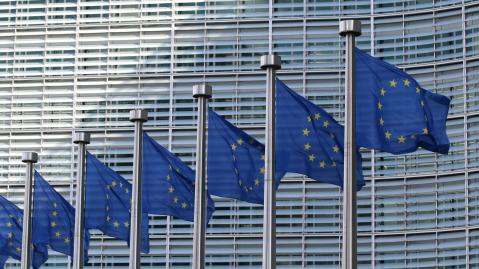UPDATED: European Council agrees on 55% 2030 target; Commission to propose ETS revisions by June 2021

On 11 December 2020, European government leaders agreed to increase the bloc’s 2030 emissions reduction goal from 40% below 1990 levels to 55%. The EU leaders also invited the Commission to explore ways to strengthen the EU ETS and to propose a carbon border adjustment mechanism.
This agreement aligns with the proposal of the European Commission in September 2020 to increase ambition for 2030 and revise the ETS in order to achieve carbon neutrality by 2050.
Commission President Ursula von der Leyen first outlined the possibility of increasing EU climate ambition from at least 40% below 1990 levels by 2030 to 50% or 55% in July 2019, which also prompted the Commission to launch a study of the potential social, economic, and environmental impacts of increasing the EU’s 2030 target. Along with explicit support for a target of at least 55% by 2030, the Commission released the results of an impact assessment (part one and part two) and policy options to reach the higher reduction goal. The package, forming the Commission’s 2030 climate target plan, is part of the Commission’s European Green Deal agenda to achieve climate neutrality by 2050.
These policy options, to be presented as legislative proposals by June 2021, include revisions and expansion of the EU ETS, adapting the Effort Sharing Regulation that applies to non-ETS sectors, strengthening energy efficiency and renewable energy targets, and establishing more stringent CO2 standards for road transport.
ETS revisions
The proposed revisions to the EU ETS would be arguably the most significant in its 15-year history, aiming to bring all sources of fossil-fuel combustion under a market-based pricing mechanism. Options for sectoral expansion include buildings and road transport through upstream coverage of heating and transport fuels, either through the existing EU ETS or as a separate ETS combining the two sectors. The EU ETS already covers the indirect emissions of buildings through district heating and electricity production, while an expansion would encompass most direct emissions from the sector.
The Commission also proposed to cover “at least intra-EU” maritime transport and evaluated its mitigation potential in the impact assessment. For intra-European Economic Area aviation, which along with electricity and industry is already included in the EU ETS, the Commission proposed reducing free allocation to improve the carbon price signal for the sector. The Commission underscored that it views international cooperation in these sectors as critical, supporting the inclusion of international emissions from aviation and maritime transport attributable to the EU into the EU ETS.
Expanded coverage under an EU-wide trading system would shift the balance between the ETS and non-ETS sectors, for which member states have national emissions targets under the EU’s Effort Sharing Regulation. On adapting the Effort Sharing Regulation, the Commission offered no concrete proposals at this stage, citing a need for further deliberation and public consultation as the upcoming review of the climate policy framework proceeds.
Cap-setting and trajectory
In the impact assessment, the Commission acknowledged that a higher 2030 target will require increasing the linear reduction factor that determines the cap trajectory as well as other adjustments to the cap. The current 2.2% annual reduction factor for Phase 4 of the EU ETS (2021-2030) will need to be increased, the Commission said, but it did not offer a specific figure. A change in the linear reduction factor could be combined with a “one-off” reduction to the cap, given that actual emissions are currently higher than the nominal cap. The size of the increase in the linear reduction factor will depend on the starting year, expansion to other sectors, and potentially adjusting the baseline of the cap downwards (a so-called “rebasing”).
While it is not discussed among the policy options in the impact assessment, the role of the EU’s supply-adjustment mechanism, the Market Stability Reserve, in addressing the gap between actual emissions and the cap will be considered as part of its first review in 2021.
The Commission said it will continue to evaluate the implications of sectoral expansion and a tighter cap trajectory on the availability of free allocation for industries that are vulnerable to the risk of carbon leakage but that the impact assessment estimates, “at first sight”, a significant amount of free allocation would remain available even under a cap aligned with the 55% reduction target. The Commission is continuing to assess alternatives to free allocation, including a carbon border adjustment mechanism narrowly targeted to certain industrial sectors.
Projections on allowance prices
Allowance prices for ETS sectors by 2030 under a 55% reduction are estimated between €32 and €65, according to the impact assessment that accompanied the plan. The lower end of the range assumes no change to the EU ETS scope, instead relying mostly on higher targets on energy efficiency, renewable energy, and other standards relative to current policies. The higher end of the range assumes both more ambitious targets on energy efficiency, renewable energy, and other standards as well as an expanded EU ETS scope.
Next steps
The new 2030 target of at least 55% emission reductions as well as the 2050 net-zero goal will be adopted in the European Climate Law, which was presented by the Commission on 17 September 2020. The European Parliament has since voted in favor of the law, while proposing to amend the 2030 target to 60%. The Environment Council on 23 October 2020 took a position in favor of the Climate Law, except the 2030 target. With the agreement of the government leaders, the EU ministers of the Environment Council are likely to agree on a complete position on the Law when they meet on 17 December.
The Commission, Council, and, Parliament will then negotiate the targets and other details, with the result entering into law and updating the EU’s NDC.

